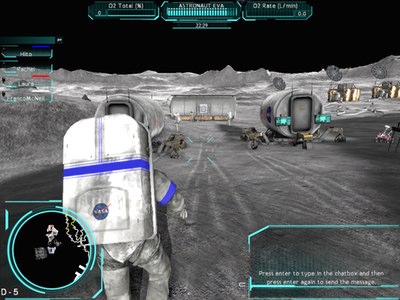Does a moonbase make for a good video game?by Jeff Foust
|
| It’s the realism of “Moonbase Alpha” that NASA hopes attracts gamers and gets them interested in real exploration. |
In “Moonbase Alpha”, a free game scheduled for release Tuesday on the Steam gaming platform, players are transported to a base in the Shackleton crater in 2025. The player is in a rover approaching the base when a meteor strike nearby cripples the base. The goal of the game is simple: in 25 minutes or less, the player (alone or working with others, via online gameplay) needs to repair the base’s solar panels and restore its life support systems. Some of that work can be done by the spacesuited astronaut, while other tasks can be carried out by rovers controlled by the player.
The game was developed by Virtual Heroes, a company best-known for the popular military game “America’s Army”, in cooperation with NASA. Many of the game’s screenshots look identical to previous NASA illustrations rendering concepts for a lunar base. It’s that realism that NASA hopes attracts gamers and gets them interested in real exploration: “The game is a proof of concept to show how NASA content could be combined with a cutting-edge game engine to produce an experience that inspires interest in science, technology, engineering and math—skills critical to achieving NASA's exploration goals,” the agency noted in a press release last week.
Unfortunately, it’s not possible for this reviewer, who had access to a beta test of the game last week, to evaluate the realism of the game itself—which hints at one of the flaws of this approach. The PC-only game (sorry, Mac users, no Moonbase Alpha for you, at least for now) requires at least Windows XP, a 2-GHz processor, and 2 GB of RAM. When testing this on a PC less than two years old that met or exceeded these requirements, the game ran very slowly and soon crashed with no explanation beyond the standard Windows dialog boxes. The flaw might have been in the graphics card: the game requires at least an NVIDIA 7000-series or ATI Radeon X1900 video card (and recommends an NVIDIA 9000+ or ATI Radeon 3600+), while this PC only had an NVIDIA 6000-series.
As the forum for beta testers of the game reported plenty of accounts of people successfully playing the game—and enjoying it—this experience is not so much a bug in the game itself but the approach NASA and the game developers chose. The emphasis on a realistic gaming environment limits the game to fairly high-end PCs. If your PC can already run some modern, graphic-intensive games, you’ll probably be able to use Moonbase Alpha smoothly. If not—because, perhaps, you have an older PC or simply prefer to play on a dedicated console like a PS3 or Xbox 360—you could run into difficulties, even if you have no problem with other, similar uses, like online video.
There is another issue with the game: its effectiveness in inspiring interest in studying science and engineering, as NASA hopes it will. The agency clearly hopes to emulate the success of America’s Army, which was developed primarily as a recruiting tool and has turn out to be very effective. However, the path between playing a combat mission on a PC and actually participating in a combat mission in Afghanistan or Iraq is much shorter and more direct than the link in Moonbase Alpha—after all, while you can play a game that involves a moonbase, you can’t yet go to one.
| Moonbase Alpha isn’t a silver bullet for NASA’s efforts at education and inspiration, but one tool in an increasingly diverse toolbox of techniques. |
That brings up another problem, one wholly beyond the scope of the game developer. When the game was first planned, it was the long-term goal of NASA to establish a settlement of some kind on the Moon, most likely in a polar crater like Shackleton, around the mid-2020s. However, in retrospect that goal was likely not attainable: the Augustine Committee found last year that the “program of record”, at its projected funding levels, would not be able to support a human return to the Moon for foreseeable future, let alone create a base of any kind. Moreover, a lunar base isn’t a goal at all in the White House’s new plans for human space exploration, as the Moon is bypassed in favor a human mission to an asteroid by 2025 and Mars missions in the 2030s and beyond. That’s no fault of the game developer, again, but a person inspired by the game but unaware of current space policy machinations could be in for a rude awakening.
All this suggests that Moonbase Alpha isn’t a silver bullet for NASA’s efforts at education and inspiration. Instead, it is one tool in an increasingly diverse toolbox of techniques needed to reach out to a public no longer held captive by a limited number of mainstream media outlets. Whether it is an effective—as well as cost effective—tool is another question that NASA will have to answer. Now, how about an asteroid landing game…
